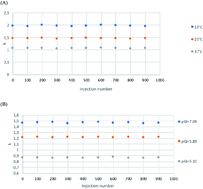Development of nano affinity columns for the study of ligand (including SARS-CoV-2 related proteins) binding to heparan sulfate proteoglycans
Abstract
The interactions of heparan sulfate proteoglycans (HSPGs) present on the cell surface with target proteins lead to cell signaling and they are considered as viral receptors. The analysis of the recognition mechanism between HSPG and its potential ligands and high-throughput screening in drug discovery thus remain important challenges. Glycidyl methacrylate-based monoliths were thus prepared in situ in miniaturized capillary columns (internal diameter 75 μm) and HSPG was grafted onto them by the use of the Schiff base method. The quantity of grafted HSPG was in the nanogram range (11 nanograms per cm of capillary length). This is of significant importance when working with less available or expensive biological material. Other advantages of our miniaturized capillary column are as follows: (i) the immobilization process of HSPG onto the organic monolithic support was reliable and reproducible. (ii) The resultant affinity capillary column showed a strong resistance to changes in temperature and pH and a negligible non-specific interaction. So as to confirm the proper functioning of our miniaturized capillary column, the molecular recognition by HSPG of five selected compounds including three ligands of interest related to SARS-CoV-2 was studied.



 Please wait while we load your content...
Please wait while we load your content...